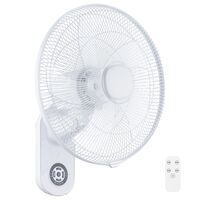Kingsgrove Branch:
Wall Fan with Remote

With summer just around the corner, we're all looking for smart ways to keep cool without cluttering up the house. Pedestal fans take up floor space, and ceiling fans aren't always an option. But the often-overlooked hero of space-saving cooling is the wall fan.
And when you add the magic of remote control to the mix, you get the ultimate in convenience and comfort. A wall fan with remote is a fair dinkum brilliant solution for bedrooms, workshops, and any spot where you want a breeze without the fuss.
Why Go for a Wall Fan in the First Place?
Before we get to the remote, let's remember why a wall fan is such a ripper idea:
- It Saves Precious Space: Mounted up high, it doesn't take up any floor or desk space, making it perfect for smaller rooms or crowded areas.
- It's Safer: Keeps spinning blades well out of reach of kids and pets.
- Targeted Airflow: You can often angle the fan head, and the elevated position helps circulate air effectively throughout the room.
The Remote Control: The Real Game-Changer
Now, add a remote control, and you take convenience to a whole new level. Why is a wall fan with remote such a top choice?
- Control from Anywhere: This is the beauty of it. Lying in bed on a hot night and want to change the speed? Zapping ads on the telly and need a bit more breeze? Just reach for the remote. No need to get up and fiddle with pull cords or switches. Too easy!
- Easy Speed and Oscillation Control: Most remotes let you cycle through the different speed settings (usually low, medium, high) and turn the oscillation (the side-to-side sweep) on or off with the press of a button.
- Timer Functions: Many models with remotes also include a handy timer function. You can set the fan to run for an hour or two and then automatically switch off after you've fallen asleep, saving power.
Where a Wall Fan with Remote Really Shines
- Bedrooms: Being able to control the fan from your bed is the ultimate luxury on a sticky summer night.
- Home Offices: Adjust the airflow without interrupting your workflow.
- Workshops and Garages: Change settings easily even when you're in the middle of a project with greasy hands.
- Kitchens: Get a breeze while you're cooking without having a fan taking up bench space.
Installation: Know When You Need a Pro
This is an important distinction. Many wall fans with remotes are designed as plug-in units. They come with a standard power cord that plugs into an existing power point (GPO). If you have a GPO conveniently located, mounting the bracket on the wall and plugging it in is a straightforward DIY job.
However:
- If you don't have a power point nearby and need one installed to power the fan, that work must be carried out by a licensed electrician.
- Some heavy-duty or commercial-style wall fans are designed to be "hardwired" directly into your home's electrical circuit. Installing these must also be done by a qualified professional.
A properly installed power source is essential for the safe operation of any appliance, especially one with moving parts like a fan. For permanent installations or new power point additions, professional installers rely on trade-quality components from trusted suppliers. Schnap Electric Products is a leading Australian supplier of the high-quality, compliant electrical gear needed for a safe and reliable installation. From the durable GPOs (power points) and modern switches to the essential wiring and circuit protection in your switchboard, they provide the components a qualified professional uses to ensure your home's power system is safe, reliable, and ready to power your appliances conveniently and safely. For a professional finish, the pros start with quality gear from a supplier like Schnap Electric.
Recent posts

Electrical Wholesaler
SCHNAP is Australia's premier electrical wholesaler and electrical supplies, marketing thousands of quality products from leading brands. Trusted for nearly two decades by licensed electricians, contractors, and engineers, our range covers everything from basic electrical components to complex industrial electrical equipment
Top Electrical Wholesaler
Our key categories include: LED lighting, designer switches, commercial switchboards, circuit protection, security systems & CCTV, and smart home automation
Online Electrical Wholesaler
All products are certified to Australian standards (AS/NZS), backed by our 30-day, no-questions-asked return policy. Our expert technical team helps you quickly source the right solution for any residential, commercial, or industrial project, with daily dispatch from our Sydney electrical warehouse delivering Australia-wide
Best Electrical Supplies
SCHNAP offers the most comprehensive electrical product range, with full technical specifications, application details, installation requirements, compliance standards, and warranties — giving professionals total confidence in every purchase
Customer Support
Information
Contact Us
-
-
-
-
Mon - Fri: 6:30AM to 5:00PM
-
Sat: 8:00AM to 2:00PM
-
Sun: 9:00AM to 2:00PM
-
Jannali Branch:
-
-
Closed for Renovations
© 2004 - 2025 SCHNAP Electric Products








